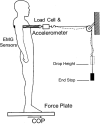Effects of spinal manipulation on sensorimotor function in low back pain patients--A randomised controlled trial
- PMID: 26319101
- PMCID: PMC4713351
- DOI: 10.1016/j.math.2015.08.001
Effects of spinal manipulation on sensorimotor function in low back pain patients--A randomised controlled trial
Abstract
Background: Low back pain (LBP) is a major health problem in industrialized societies. Spinal manipulation (SM) is often used for treating LBP, though the therapeutic mechanisms remain elusive. Research suggests that sensorimotor changes may be involved in LBP. It is hypothesized that SM may generate its beneficial effects by affecting sensorimotor functions.
Objectives: To compare changes in sensorimotor function, as measured by postural sway and response to sudden load, in LBP patients following the delivery of high-velocity low amplitude (HVLA)-SM or low-velocity variable amplitude (LVVA)-SM versus a sham control intervention.
Design: A three-arm (1:1:1 ratio) randomized controlled trial.
Methods: A total of 221 participants who were between 21 and 65 years, having LBP intensity (numerical rating scale) ≥4 at either phone screen or the first baseline visit and ≥2 at phone screen and both baseline visits, and Quebec Task Force diagnostic classifications of 1, 2, 3 or 7 were enrolled to receive four SM treatments over two weeks. Study outcomes were measured at the first and fifth visits with the examiners blinded from participant group assignment.
Results: The LVVA-SM group demonstrated a significant increase in medial-to-lateral postural excursion on the soft surface at the first visit when compared to the control group. No other significant between-group differences were found for the two sensorimotor tests, whether during the first visit or over two weeks.
Conclusions: It appears that short-term SM does not affect the sensorimotor functions as measured by postural sway and response to sudden load in this study.
Trial registration: ClinicalTrials.gov NCT00830596.
Keywords: Clinical trial; Low back pain; Sensorimotor function; Spinal manipulation.
Copyright © 2015 Elsevier Ltd. All rights reserved.
Figures


Comment in
-
Spinal Manipulation Unable to Demonstrate Improved Sensorimotor Function.J Am Osteopath Assoc. 2016 Jan 1;116(1):56. doi: 10.7556/jaoa.2016.010. J Am Osteopath Assoc. 2016. PMID: 27270350 No abstract available.
-
Spinal Manipulation and Mobilization Therapy for Cervicogenic Headache.J Am Osteopath Assoc. 2017 Jan 1;117(1):58-59. doi: 10.7556/jaoa.2017.010. J Am Osteopath Assoc. 2017. PMID: 28055091 No abstract available.
References
-
- Ashton-Miller JA, Wojtys EM, Huston LJ. Fry-Welch D: Can proprioception really be improved by exercises? Knee Surg Sports Traumatol Arthrosc. 2001;9(3):128–136. - PubMed
-
- Brumagne S, Cordo P, Lysens R, Verschueren S, Swinnen S. The role of paraspinal muscle spindles in lumbosacral position sense in individuals with and without low back pain. Spine. 2000;25(8):989–94. - PubMed
-
- Cholewicki J, Silfies SP, Shah RA, Greene HS, Reeves NP, Alvi K, Goldberg B. Delayed trunk muscle reflex responses increase the risk of low back injuries. Spine. 2005;30(23):2614–20. - PubMed
-
- Christensen MG, Kollasch MW, Hyland JK. Practice Analysis of Chiropractic 2010: A project report, survey analysis, and summary of chiropractic practice in the United States. National Board of Chiropractic Examiners; Greeley, Colorado: 2010. pp. 1–236.
-
- Cox J. Low back pain: Mechanism, diagnosis and treatment. Williams and Wilkins; Baltimore: 1999. pp. 1–736.
Publication types
MeSH terms
Associated data
Grants and funding
LinkOut - more resources
Full Text Sources
Other Literature Sources
Medical
Miscellaneous

